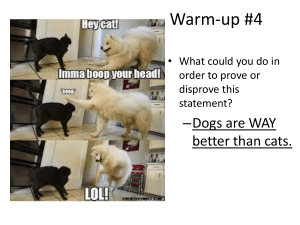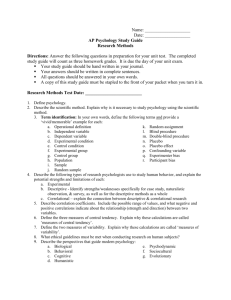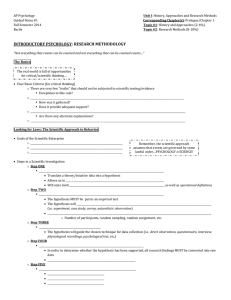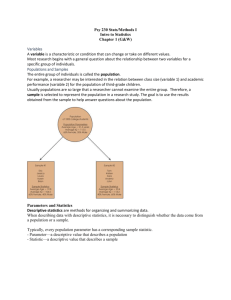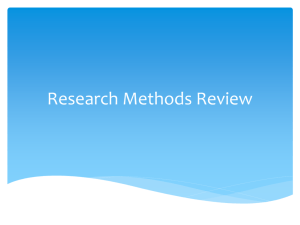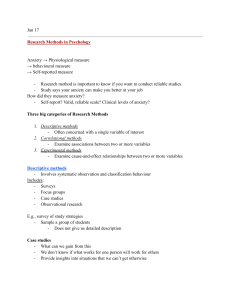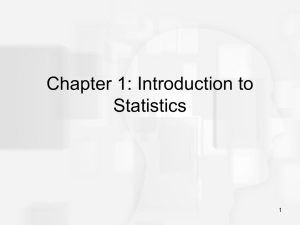Module 2 - AP Psychology Community
advertisement
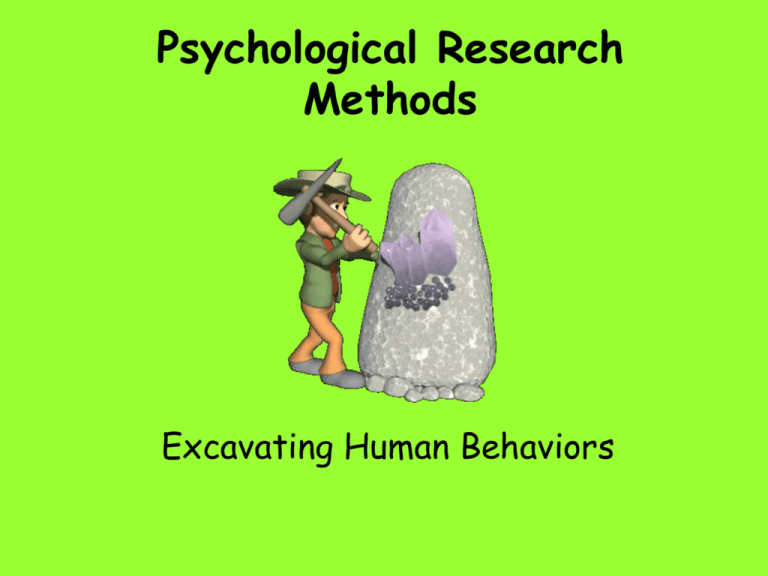
Psychological Research Methods Excavating Human Behaviors Hindsight Bias • The tendency to believe, after learning the outcome, that you knew it all along. Only after Kerry won the Iowa Primary, did people begin to say that Dean was too liberal. What would people say about Kerry if Dean won? Overconfidence • We tend to think we know more than we do. 82% of U.S. drivers consider themselves to be in the top 30% of their group in terms of safety 81% of new business owners felt they had an excellent chance of their businesses succeeding. When asked about the success of their peers, the answer was only 39%. (Now that's overconfidence!!!) Scientific Method 1. Observe some aspect of the universe. 2. Invent a theory that is consistent with what you have observed. 3. Use the theory to make predictions. 4. Test those predictions by experiments or further observations. 5. Modify the theory in the light of your results. 6. Go to step 3. Hypothesis • A tentative theory that has not yet been tested. •Have operational definitions. •Be replicable. Types of Research • Descriptive • Correlational • Experimental What is going on in this picture? We cannot say exactly, but we can describe what we see. Thus we have….. Descriptive Research • Any research that observes and records. • Does not talk about relationships, it just describes. Types of Descriptive Research • The Case Study • The Survey • Naturalistic Observation The Case Study • Where one person (or situation) is observed in depth. What are the strengths and weaknesses of using a tragedy like the Columbine School Shootings as a case study? The Survey Method • Used in both descriptional and correlational research. • Use Interview, mail, phone, internet etc… • The Good- cheap, anonymous, diverse population, and easy to get random sampling (a sampling that represents your population you want to study). Random Sampling Why do we sample? • One reason is the False Consensus Effect: the tendency to overestimate the extent to which others share our beliefs and behaviors. Survey Method: The Bad • Low Response Rate • People Lie or just misinterpret themselves. • Wording Effects How accurate would a survey be about the frequency of diarrhea? Naturalistic Observation • Observing and recording behavior in natural environment. • No control- just an observer. What are the benefits and detriments of Naturalistic Observation? Correlational Research • Detects relationships between variables. • Does NOT say that one variable causes another. There is a positive correlation between ice cream and murder rates. Does that mean that ice cream causes murder? Measured using a correlation coefficient. • A statistical measure of the extent to which two factors relate to one another How to Read a Correlation Coefficient Experimental Research • Explores cause and effect relationships. Eating too many bananas causes Constipation Steps in Designing an Experiment 1. Hypothesis 2. Pick Population: Random Selection then Random Assignment. 3. Operationalize the Variables 4. Identify Independent and Dependent Variables. 5. Look for Extraneous Variables 6. Type of Experiment: Blind, Double Blind etc.. 7. Gather Data 8. Analyze Results Experimental Vocabulary • Independent Variable: factor that is manipulated • Dependent Variable: factor that is measured • Extraneous Variables: factors that effect DV, that are not IV. • Experimental Group: Group exposed to IV • Control Group: Group not exposed to IV • Placebo: inert substance that is in place of IV in Control Group Analyze Results • Use measures of central tendency (mean, median and mode). • Use measures of variation (range and standard deviation). A Skewed Distribution Are the results positively or negatively skewed?


